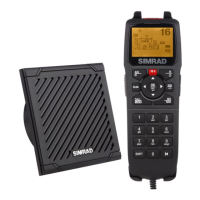
Do you have a question about the Simrad RS90 and is the answer not in the manual?
| Type | VHF Marine Radio |
|---|---|
| Frequency Range | 156.000 - 163.425 MHz |
| DSC Functionality | Yes |
| Display | LCD |
| Waterproof Rating | IPX7 |
| NMEA 2000 | Yes |
| AIS | Yes |
| Channels | International, US, Canadian |
| GPS | Built-in |
| Voltage Range | 12V |
| Output Power | 25 W / 1 W (high/low) |
Introduces the RS90 VHF radio and its key features.
Details the main component of the RS90 system.
Illustrates the system components and their connections.
Explains the types, operation, and naming of RS90 handsets.
Describes the dynamic soft keys displayed on the screen.
Procedure to power on the RS90 radio system.
Procedure to power off the RS90 radio system.
Explains how the radio scans selected channels for activity.
Displays distance and bearing to a selected waypoint.
Allows hailing other vessels or crew via a loud-hailer speaker.
Procedure for entering data using the wired handset keypad.
Procedure for entering data using a wireless handset.
Steps for making a ship-to-ship or ship-to-shore call.
How to call a contact using their MMSI via DSC.
Scans the selected channel and channel 16.
Scans three favourite channels and the priority channel.
Initiates and uses the ALL SCAN mode.
How to activate and use the voice recorder function.
How to play back recorded voice communications.
Steps to enter a new waypoint with name, latitude, and longitude.
How to choose a waypoint from the stored list for navigation.
How to select the closest waypoint for navigation.
Explains Digital Selective Calling and its purpose.
Describes the steps involved in a DSC call and acknowledgment.
Procedure to send an immediate, unspecified distress call.
Procedure to send a distress call with a specified nature of distress.
Details the radio's response to a distress acknowledgement signal.
Details the radio's response to a distress relay signal.
Explains the common actions the radio takes when receiving a DSC call.
Displays a list of vessels detected by AIS.
Shows the geographical layout of AIS targets.
Lists vessels that meet Time/Closest Point of Approach criteria.
Explains the symbols used on the Plan Position Indicator display.
Procedures for setting up wireless handsets.
How to register a wireless handset with the transceiver.
How to select USA, International, or Canadian channel banks.
How to assign or change names for VHF channels.
How to enter or check the unique 9-digit MMSI.
Explains what a group MMSI is and how it's used.
How to turn the AIS receiver function on or off.
How to choose between vessel name or MMSI display.
How to configure the NMEA port baud rate for AIS data.
How to manually input location and time if GPS is unavailable.
How to set radio sensitivity to LOCAL or DISTANT.
How to adjust the screen contrast.
How to enable or disable the GPS simulator for testing.
Lists common radio problems and their solutions.
Controls handset and external speaker volume.
Switches directly to the priority channel (16 or 9).
Initiates a DSC distress call.
Activates the microphone and transmits voice.
Confirms selections and sets transmission power.
Accesses DSC menu or main menu.
Enters navigation mode to display waypoint information.
Toggles between favourite channels and zooms PPI.
Initiates scanning, soft key in DSC, zooms PPI.
Stores MMSI groups, GPS waypoints, and automatic updates.
Covers communication modes, watch capabilities, channel scans, and power settings.
Details handset waterproofing, charging, backlighting, and contrast.
Dedicated CH70 receiver, priority channel access, DSC capability.
Describes Class A AIS transceivers for large vessels.
Describes Class B AIS transceivers, typically lower cost.
Lists general specifications like temperature, voltage, dimensions, weight.
Details receiver specifications like frequency, sensitivity, and distortion.
Details transmitter specifications like frequency error, RF power, and deviation.
Lists communication port specifications like NMEA versions and baud rates.
Covers AIS function, receiver frequency, and supported info.
Details unit limit, frequency, sensitivity, current, power, range, and cradle specs.
Lists international VHF channels, frequencies, and modes.
Lists EU international VHF channels, frequencies, and modes.